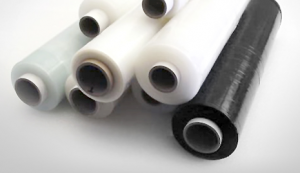What exactly is plastic sheeting?
Plastic film can relate to a broad category of products, ranging from rolls of film sold by thickness up to 10 mils, to groups of flexible packaging products such as bags, bottles and containers used in various industries. For the purpose of this post, we want to explore the options and terminology of plastic sheeting as the packaging product generally purchased by the roll, with a specified width and mil thickness to work within a distinct application.
Plastic sheeting can be used for masonry, construction, landscaping and within a multitude of additional industries. Plastic sheeting is exceptional for covering and protecting skids, lumber, warehouse equipment, machinery, and construction materials. Plastic sheeting packaging provides optimal economy, performance, and toughness.
Below is a guide to the terminology generally used when deciding the best plastic sheeting option for your application.
Plastic Sheeting: General Terminology
Gloss: The film's surface reflection of light. The degree of sheen of the surface.
Haze: The degree of cloudiness of the film. Indicates how clearly an object can be seen through the film.
Opaque: Film that inhibits light transmission. The opposite of transparent.
Tint: Tiny voids in the film, enabling water, air, etc. to pass through the film.
Translucent: A film that permits the transmission of light. Clear, transparent.
Plastic Sheeting Film Measurement
Film: Sheeting having a nominal thickness not greater than .010 inch (10 mil).
Tolerance: A specified allowance for deviations in weighing, measuring, etc
Mil: One thousandth of an inch
Density: Weight per volume
Ream: 500 sheets, 2' x 3'. Equivalent is 3,000 sq. ft. or 432,000 sq. in
Basis Weight: The weight, in pounds, of 1 ream of film. Will vary on density and thickness.
Yield: The square inches of film yielded per pound. Will vary on density and thickness.
Plastic Sheeting Film Properties
Orientation: Alignment of the crystalline structure in film in both the machine and transverse directions.
Shrink: The ability of film to conform to an object when reheated. A result of controlled orientation.
Impact Strength: The ability of a film to withstand shock loading, blunt puncturing, etc.
Tensile Yield: The pulling stress required to deform a given film specimen.
Tensile Break: The pulling stress required to break a given film specimen.
Elongation: A measure of how much a film can stretch over a given load profile.
Coefficient of Friction: The ratio of a frictional gravitational force to the perpendicular force of the two surfaces in contact.
Treat: A method of altering a polyolefin surface to render it receptive to inks, adhesives, etc.
Water Vapor Transmission Rate: Rate at which water vapor permeates a plastic film at a specified temperature and relative humidity.
Oxygen Transmission Rate: Rate at which oxygen permeates a plastic film at a specified temperature and relative humidity
Surface Resistivity: Measures the electrical resistance of the surface of the plastic.
Antiblock: A silica or DE compound added to film that roughens the surface to prevent blocking.
Antistat: A compound added to film that dissipates the accumulation of static electricity.
Slip: A fatty acid amide added to film to reduce surface friction.
Ultraviolet Absorber: A compound designed to selectively absorb pass through UV rays.
Ultra Violet Inhibitor: A compound designed to selectively scavenge destructive free radicals set free by UV rays
Ultraviolet Blocker: A compound designed to selectively block pass through UV rays.
Vapor Corrosion Inhibitor: A compound added to film for the prevention of oxidation or corrosion of packaged parts.
Process Terminology
Extrusion: The breaking down and reshaping of materials by forcing it through an orifice.
Resin Types & Terms
Low Density Polyethylene: An ethylene based thermoplastic polymer with a nominal density of .910-.925.
Medium Density Polyethylene: An ethylene based thermoplastic polymer with a nominal density of .926-.939.
High Density Polyethylene: An ethylene based thermoplastic polymer with a nominal density of .940-.965.
Linear Low Density Polyethylene: A low density, low pressure polymer resulting from the introduction of comonomers to control density.
Butene LLDPE: Lowest grade of LLDPE, this polymer still outperforms LDPE in strength and sealabilty.
Hexene LLDPE: Next level of LLDPE, this polymer has improved tear and impact over butene.
Super Hexene LLDPE: Highest level of LLDPE, has excellent tear strength and dart impact, with optics improving.
Octene LLDPE: Highest level of LLDPE, has excellent tear strength, very good dart impact and better optics.
Metallocene LLDPE: LLDPE with unsurpassed dart impact, very high clarity, good tear strength and very good hot tack.
Very Low Density Polyethylene: A low pressure copolymer with outstanding impact strength, stretch and low temperature sealabilty.
Ethylene Vinyl Acetate: LDPE that has been copolymerized with ethylene vinyl acetate to enhance strength and sealability.
Thermoplastic: Polymeric material capable of being repeatedly softened by heat and hardened by cooling.
Winding Configurations
Single Wound Sheeting: A single layer of film, cut on both sides.
Double Wound Sheeting: A double layer of film, cut evenly on both sides
Centerfold Sheeting: A double layer of film, cut evenly on one side, folded on the other.
J Sheeting: A double layer of film, cut to different lengths on one side, folded on the other.
M Sheeting: Centerfold sheeting that's folded inward on the crease side.
U Sheeting: A double layer of film, folded on both sides, with a (center) section cut out on one side.
Sheets on Roll: A continuous, single layer of film, separated by perforations and wound on a roll.



